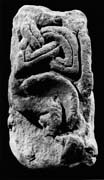Select a site alphabetically from the choices shown in the box below. Alternatively, browse sculptural examples using the Forward/Back buttons.
Chapters for this volume, along with copies of original in-text images, are available here.
Object type: Part of cross-shaft [1]
Measurements: H. 40.5 cm (16 in); W. 22 cm (8.7 in); D. 15.8 cm (6.25 in)
Stone type: Medium-grained, yellowish-brown (10YR 6/4–6/6) grit; see no. 2.
Plate numbers in printed volume: 20-23
Corpus volume reference: Vol 3 p. 56-57
(There may be more views or larger images available for this item. Click on the thumbnail image to view.)
A (broad): The plain edge moulding survives only on one side. The panel has two motifs but no transverse division between them. At the top is the terminal of an interlace, in the form of a simple pattern E knot using broad, median-incised strands, its points fitting round the curve of a dished nimbus below. There are slight traces of a head within, but the stone has been very damaged here.
B (narrow): One edge moulding is damaged; the other plain. The panel contains a single profile animal with double outline, spread fore legs and scrolled joint. A median-incised band crosses it. Its incised eye is elliptical. The fettering may be extensions from the head and acts as a filler. The transverse moulding remains in front of the beast.
C (broad): Only one moulding survives; the other is plain. The panel is filled with irregularly set out and very deeply cut interlace using median-incised strands. The pattern comprised one register and part of a second of complete pattern A.
D (narrow): The plain edge mouldings flank a bird, its body in double outline. The wings, tail and neck are bound by a median-incised strand. A second bird with more rounded head follows behind.
This shaft is the epitome of Anglo-Scandinavian work, for the nimbed portrait is a descendant of the eighth-century tradition found in the western parts of Yorkshire at Otley, which continues through the ninth on monuments at Easby, and Collingham, to the tenth at Leeds (Cramp 1970, pl. 46, 1–2, pl. 47, 2–4; Collingwood 1915, 212, fig. 1) and Newgate 1 at York (Ills. 342–6). Unlike the latter, the halo is not cruciferous, so the figure may not be Christ.
This unbroken Anglian sequence is accompanied by adjacent zoomorphic panels which are in the new tenth-century fashion for York. (For their Jellinge and Insular attributes, see no. 2, and Chap. 9).
The bird-chain has some variety in design of the heads, unlike no. 2 (Fig. 7g). The drooping tails should be compared locally with St Mary Castlegate 1 (Ill. 294) and Sutton upon Derwent 1 (Ill. 869), and, more widely, with Mercian examples at Derby and Gloucester (Lang 1978b, 147, fig. 8.1A–B).
1. All the pieces from the Minster were discovered as a result of the excavations of 1966-71 by H. Ramm and D. Phillips. They are to be published as a handlist, together with a critical essay, in the forthcoming Royal Commission volume on the excavations. That publication will provide the finer detail of their archaeological contexts, both in a table, and in a description of the excavation of the south transept cemetery.
The following are general references to the stones: Wilson 1978, 142; Hall 1980b, 7, 21; Lang 1988b, 8, 12; Lang 1989, 5.



